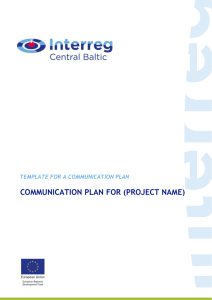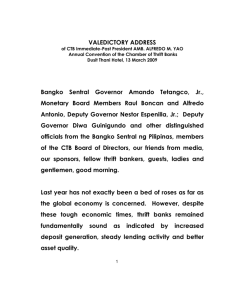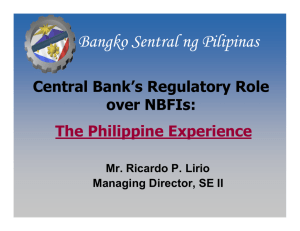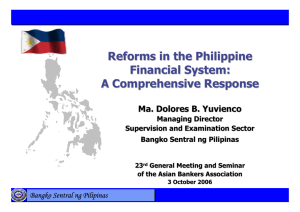THE BSP'S BUSINESS EXPECTATIONS SURVEY
advertisement
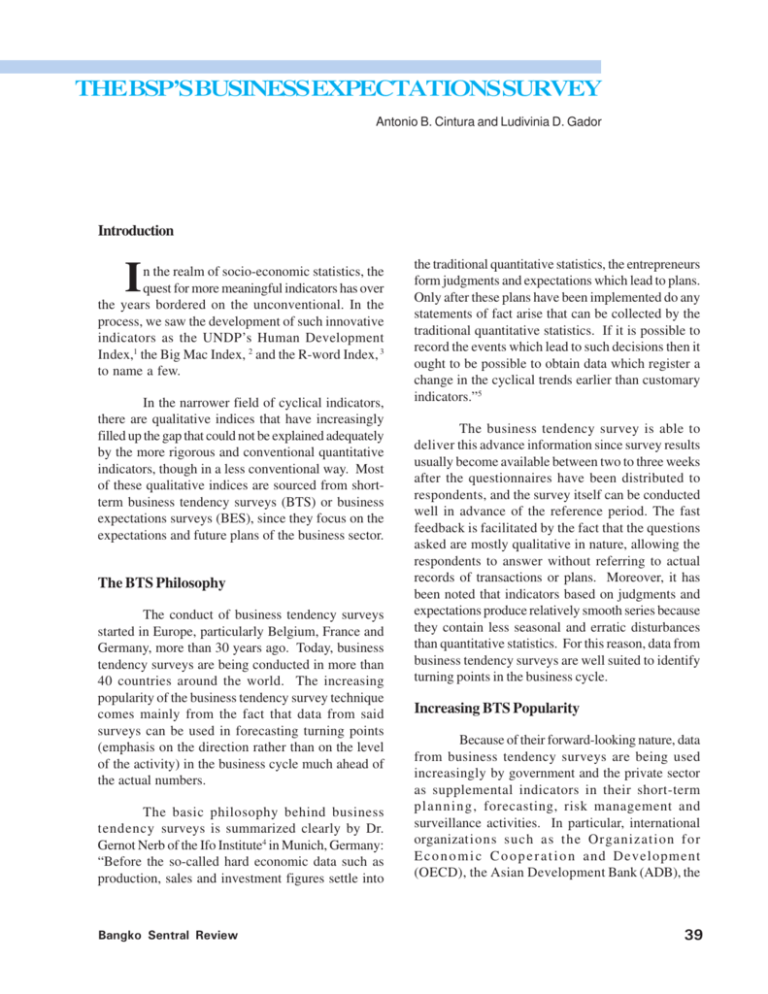
THE BSP’S BUSINESS EXPECTATIONS SURVEY Antonio B. Cintura and Ludivinia D. Gador Introduction I n the realm of socio-economic statistics, the quest for more meaningful indicators has over the years bordered on the unconventional. In the process, we saw the development of such innovative indicators as the UNDP’s Human Development Index,1 the Big Mac Index, 2 and the R-word Index, 3 to name a few. In the narrower field of cyclical indicators, there are qualitative indices that have increasingly filled up the gap that could not be explained adequately by the more rigorous and conventional quantitative indicators, though in a less conventional way. Most of these qualitative indices are sourced from shortterm business tendency surveys (BTS) or business expectations surveys (BES), since they focus on the expectations and future plans of the business sector. The BTS Philosophy The conduct of business tendency surveys started in Europe, particularly Belgium, France and Germany, more than 30 years ago. Today, business tendency surveys are being conducted in more than 40 countries around the world. The increasing popularity of the business tendency survey technique comes mainly from the fact that data from said surveys can be used in forecasting turning points (emphasis on the direction rather than on the level of the activity) in the business cycle much ahead of the actual numbers. The basic philosophy behind business tendency surveys is summarized clearly by Dr. Gernot Nerb of the Ifo Institute4 in Munich, Germany: “Before the so-called hard economic data such as production, sales and investment figures settle into Bangko Sentral Review the traditional quantitative statistics, the entrepreneurs form judgments and expectations which lead to plans. Only after these plans have been implemented do any statements of fact arise that can be collected by the traditional quantitative statistics. If it is possible to record the events which lead to such decisions then it ought to be possible to obtain data which register a change in the cyclical trends earlier than customary indicators.”5 The business tendency survey is able to deliver this advance information since survey results usually become available between two to three weeks after the questionnaires have been distributed to respondents, and the survey itself can be conducted well in advance of the reference period. The fast feedback is facilitated by the fact that the questions asked are mostly qualitative in nature, allowing the respondents to answer without referring to actual records of transactions or plans. Moreover, it has been noted that indicators based on judgments and expectations produce relatively smooth series because they contain less seasonal and erratic disturbances than quantitative statistics. For this reason, data from business tendency surveys are well suited to identify turning points in the business cycle. Increasing BTS Popularity Because of their forward-looking nature, data from business tendency surveys are being used increasingly by government and the private sector as supplemental indicators in their short-term planning, forecasting, risk management and surveillance activities. In particular, international organizations such as the Organization for E c o n o m i c C o o p e r a t i o n and Development (OECD), the Asian Development Bank (ADB), the 39 Association of South East Asian Nations (ASEAN) and the Bank for International Settlements (BIS) have included business survey data in their set of macro prudential indicators.6 Aside from the Ifo’s seminal business surveys, an example of a business tendency survey that is closer to home is the Bank of Japan’s Tankan (Tanki Keizai Kansomo Chousa), a short-term economic survey of enterprises in Japan.7 The BOJ uses the Tankan for taking a pulse of the current economic situation, especially that of the private sector, and for confirming the outlook for the economy that is derived from other statistical sources. Tankan data are also used for ad hoc research on the corporate sector. BTS in the Philippines In the Philippines, there are several business tendency surveys being conducted by the private sector. These include those being done by the Social Weather Station, Pulse Asia, Makati Business Club and Business World (in collaboration with New Yorkbased RoperASW Asia Pacific). The first two are the more popular ones, and are used mainly for very short-term, politically and socially-focused issues such as election trends and popularity ratings. The last two are closer to the Tankan in terms of regularity (quarterly and semestral surveys) and coverage (business and consumer expectations). The closest Philippine business tendency survey to the Tankan, however, is the Bangko Sentral’s Business Expectations Survey, mainly because it is also being conducted by a monetary authority and the format and compilation methods have recently been harmonized with those of the Tankan survey. BSP’s Old Survey on Business Expectations In 1986, in response to the growing need to feel the pulse of the business industry, the Department of Economic Research-Domestic (DER-D) of the then Central Bank of the Philippines designed and initiated the conduct of the semestral Survey on Business Expectations. The survey was intended primarily to provide the Monetary Board with indicators on the current and prospective outlook of the business sector. 40 Specifically, the survey was designed to generate quantitative measures of projected semi-annual percentage changes in selected business variables that can be used as indicators of general business conditions and tendencies. The survey also provided measures of the expected financial performance of an industry that would indicate whether an industry is anticipating “improving”, “unchanged”, or “worsening” financial conditions. In addition, the survey sought to get the perceptions of business and industry regarding the short-term prospects of the economy. Survey methodology The survey covered three half-year periods: previous, current and next semesters. To measure the degree of optimism or pessimism in business and industry, officials holding managerial and other responsible positions in various firms were asked to indicate their expected semestral percentage changes on 17 key business variables. 8 Actual values of the variables were supplied for the previous semester, while expected semestral changes on the variables were indicated for the current and next semesters. A sample size of 300 was drawn from the Securities and E x c h a n g e C o m m i s s i o n ’s l i s t o f t o p 1 0 0 0 corporations in the Philippines in 1984, stratified by industry in accordance with the 1977 Philippine Standard Industrial Classification (PSIC) manual. The survey was done through questionnaires that were delivered personally to respondent-firms by DER-D’s field researchers. The filled-up forms were expected to be returned by respondent-firms by fax or post to the DER-D within ten days after receipt. S i n c e 1 9 9 4 , h o w e v e r, f o l l o w i n g t h e reorganization of the BSP when there was a substantial streamlining of personnel, the delivery and retrieval of the questionnaires were done through a contracted courier. Analysis and presentation The relative weighted average method was used for computing the overall index of business expectations. 9 The estimation was done for each of the selected business variables for every industry group, and the industry group estimates were combined to obtain an overall estimate for the target population. Bangko Sentral Review Based on the initial results obtained from the survey, seven summary tables were constructed.10 The results and analysis of the survey were distributed to respondent-firms and government agencies for information and guidance in policy formulation. The survey reports were not published but were made available upon request by any interested party. BSP’s Harmonized Business Expectations Survey While several countries in the Asia-Pacific region have been conducting business tendency surveys based on their specific needs and concepts since the 1980s, efforts at harmonization to facilitate inter-country comparison only started in the 1990s. One of the major efforts toward this end was initiated in November 1999, when the ADB implemented a regional technical assistance program (RETA 5938) to help harmonize and strengthen the business tendency surveys being conducted in selected Asian countries. The Philippines was included among the five countries covered initially by the RETA.11 These countries were encouraged to adopt a core set of standard questions recommended by the OECD to facilitate inter-country comparisons. As a result, the BES questionnaire and methodology were revised to make them consistent with those of other countries in the region. Questions were harmonized in terms of content (questions or variables included in the questionnaire), type of variables (form of question) and period covered. Likewise, the frequency and reference periods were revised from semestral to quarterly to make the survey results more useful as leading indicators. Revised methodology The sample firms were drawn from the SEC’s list of top 3,000 corporations in Metro Manila in terms of net sales in 1999 (published in 2000). A sample of 510 corporations was drawn using the stratified random sampling method. The sample was updated this year based on the 2001 issue of the SEC’s top 3000 corporations in Metro Manila in 2000, bringing the total sample size to 600. The firms were stratified according to the expanded (from nine to twelve) industry groupings in the 1994 PSIC, as follows: (1) agriculture, fishery & forestry, (2) mining and quarrying, (3) manufacturing, (4) Bangko Sentral Review electricity, gas and water, (5) construction, (6) wholesale and retail trade, (7) hotels & restaurants, (8) transport, storage and communications, (9) financial intermediation, (10) real estate, (11) renting and other business activities and (12) community, social & personal services. The overall sample size was determined using the Neyman’s Optimum Allocation formula which took into consideration the variances within and among the twelve industry groups of the business variables.12 The questionnaires are sent by fax or e-mail to the sample firms and the accomplished forms are mailed, faxed or e-mailed back by respondents to DER within ten days from the day of receipt. Follow-up through telephone calls are made if necessary. In case of non-participation/closing-shop by sample firms, replacements are drawn from the original listing in order to retain the desired sample size, with the substitute firms being chosen randomly from the same sector. Revised questionnaire One major revision in the new BES questionnaire is the change in the possible answers from quantitative to qualitative mode. Qualitative questions of the threefold, multiple-choice type (e.g., “easy, normal, tight”; “up, no change, down”) are used in almost all variables,13 instead of the quantitative changes asked in the old survey. The new BES questionnaire has basically five parts: (1) overall business outlook, (2) present tendencies, (3) limiting factors, (4) future tendencies and (5) economic indicators. The sample respondents are re-grouped into four major sectors: (1) agriculture, mining, electricity and manufacturing sector; (2) construction, (3) trade, and (4) services. Correspondingly, four sets of questions are also prepared, which are applicable only to specific sectors in the sample. Under the overall business outlook section, the respondents are asked about their overall business expectations for both the current quarter and the next. The three possible answers are “improving”, “no change” or “deteriorating”. An open question on the reasons underlying the respondents’ overall outlook was included to 41 obtain more objective and comprehensive analysis. The economic indicators included in the questionnaire are the average peso borrowing rate, the average exchange rate and the average inflation rate. by getting the averages of the diffusion indices of the business variables identified for each sector. Qualitative data on expansion plans and limiting factors to b u s i n e s s a c t i v i t y a s w e l l a s quantitative data on employment and capacity utilization are also generated. Processing the data Encouraging Initial Results Unlike in the old BES where the percentage shares of the responses were simply reported and summarized, under the harmonized BES, the survey data are processed further to compute for diffusion indices. The process involves: (a) adding up the number of firms with the same response in each sector; (b) computing for the percentage distribution based on the total number of firms in the sector; and (c) subtracting the percentage shares of the negative answers from the percentage shares of the positive answers, and disregarding the percentage shares of the “no change” or “normal” responses, to generate the diffusion index for each sector for each variable. In effect, the diffusion index operationalizes the focus of business tendency surveys, which is to monitor the expected direction in the movement of a variable and anticipate possible turning points. The harmonized BES was launched in the second quarter of 2001. Despite the still limited scope (six quarterly observations) for analysis of the new data series, some encouraging trends have already been noted.14 In particular, using graphical inspection, the BOIC line appears to be a good coincident indicator of short-term economic growth (Chart 1). Since the second quarter of 2001, the BOIC has traced consistently the direction of the GDP growth for the current quarter. Moreover, since the results of the survey are released well ahead of the actual GDP data even for the current quarter, the BOIC also serves effectively as a leading indicator for the current quarter GDP. The BOIN line also appears to track well the GDP growth path, except in the fourth quarter of 2001 when business expectations were heavily colored by the September 11 event. Similarly, the diffusion indices for the four major sectors, particularly the indices for the current quarter, exhibit generally the same trend as the BOIC and BOIN (Charts 2-5). The same is true for the index on capacity utilization (Chart 6). The indices on economic indicators, however, show mixed t r e n d s , i n d i c a t i n g t h a t b u s i n e s s expectations on t h i s a r e a a r e g e n e r a l l y perceptions on activities that business managers themselves have no direct participation or control (Charts 7-9). Overall, however, both current and next quarter indices computed from the BES appear to be promising leading indicators of short-term economic performance, given that improvements in the survey are continuing. One significant indicator of confidence on these new indices is the fact that the IMF has started using the results of the survey in its monitoring of global market d e v e l o p ments. 15 Survey results are also disseminated through regular press releases and made available in the BSP website. From the survey data, several diffusion indices are generated. The most important ones are the diffusion indices for the overall business outlook for the current quarter (BOIC) and the next quarter (BOIN). These two summarize the general business trend for the period covered by the survey. They are generated from the weighted averages of the diffusion indices of the four major sectors (agriculture and industry; construction; trade; and services), which are, in turn, computed from the weighted diffusion indices of the original 12 sectors of the economy based on the 1994 PSIC. The weights are based on the number of firms selected for each group relative to the total sample size. Diffusion indices are also generated for the three key economic indicators (inflation, exchange rate and interest rate) for the four major groups and the whole economy. In addition, confidence or composite indicators for the four major sectors are computed 42 Bangko Sentral Review Bangko Sentral Review 43 44 Bangko Sentral Review Bangko Sentral Review 45 46 Bangko Sentral Review Future Tendencies Going forward, as the survey’s data series lengthens to allow for more rigorous statistical analysis, the usefulness of the survey as a source for reliable leading indicators for short-term business trends in the economy will be further validated. In this connection, the possibility of transforming data from the old BES into the new data series will also be examined. Over time, the survey’s response rate is expected to improve, making room for more representative trend lines. More intensive use of composite indicators is also being contemplated, allowing for less volatile data and more meaningful analysis of sectoral behavior. Moreover, improved analytical skills in interpreting the survey results are expected to be acquired over time by the staff as they gain greater familiarity with the data’s nuances and explanatory power. Greater transparency in the conduct of the survey will also continue to be promoted through, among other activities, regular seminars for users of the survey data and more Bangko Sentral Review intensive dissemination of the survey results to ensure more active participation from the private sector. In terms of frequency, if the shift to a monthly mode is not feasible in the near term, then the quarterly survey can be supplemented by small, special surveys for the purpose of feeling the pulse of the business sector during times of major shocks in the economy. Moreover, since the BSP’s primary mandate is directly related to price stability, complementing the business expectations survey with a consumer expectations survey will be explored. Overall, these initiatives are expected to contribute to a wider database for monitoring the risks attendant to the BSP’s conduct of monetary policy in general and inflation targeting activities in particular. In the process, it is hoped that the BSP, in its efforts to improve the quality and delivery of its BES and other leading indicators, can contribute significantly to a more meaningful measurement of the state of economic welfare of the public. 47 The Authors Cintura Gador Antonio B. Cintura is Acting Deputy Director at Economic and Financial Monitoring Group of the Department of Economic Research. Mr. Cintura holds a Bachelor of Arts degree in Economics and a Bachelor of Science degree in Business Administration (Accounting) from the Ateneo de Naga University, and a diploma in Development Economics from the University of the Phiippines. He is also a Certified Public Accountant. Ms. Ludivinia D. Gador is Bank Officer VI at the Economic and Financial Monitoring Group of the Department of Economic Research. Ms. Gador holds a Bachelor of Science Degree in Mathematics from the Far Eastern University and has earned masteral units in Mathematics from the Manuel L. Quezon University. Endnotes 1. The Human Development Index includes, in addition to the usual data on economic growth such as GDP, other socio-economic indices such as life expectancy and educational attainment data in the measurement of the overall development of a country. In the words of Mr. Thinley, HDI “is the most innovative yardstick towards measuring the ends or objectives of development.” 2. The Big Mac Index is a light-hearted measure of exchange rate trends. Based on the purchasing power parity theory, it uses McDonald’s most popular product to comprise the “identical basket of commodities” for determining whether a currency is at its “correct” or “fair” level. For discussion of the index, see Neil Angelo Halcon’s article, “ The ‘Big Mac’ Index,” Bangko Sentral Review, January 2002, IV: 1. 3. The R-word Index (Recession Index) is an alternative indicator of economic activity proposed by The Economist more than a decade ago. Using a computer database, the magazine counted for each quarter how many stories in the British newspapers had the word “recession”. The index has since then been found to closely mirror the economic cycle, turning direction at roughly the same time as output. But unlike official statistics that come with a lag, the index is instantly available to the public. In early 2001, The Economist started to use the R-word Index to track the US economy, using the New York Times and Washington Post as reference newspapers. Shortly thereafter, the idea was applied by HypoVeriensbank in constructing the R-word Index for Germany. 4. The Ifo Institute for Economic Research was founded in 1949 as an independent, non-profit research organization. The name Ifo was derived from the words information and Forschung, which means research. 5. G. Nerb, 2001. “Brief Description of Business Surveys, Methodological and Practical Problems,” in Proceedings of the Joint ADB/OECD/ESCAP Workshop on Harmonizing and Strengthening Business Tendency Surveys in Developing Countries in the Pacific Region held on 21-24 November 2000 in Bangkok, Thailand; OECD, Paris, France, p. 165. 6. For instance, OECD has 31 percent of its leading indicators coming from business and consumer surveys, while ADB has a section on qualitative indicators generated from business survey data. 7. See for example, Satoshi Saito, May 2001. “Utilization of the Tankan,” in Proceedings of the Joint OECD-ADB-ESCAP Workshop on Business Tendency Surveys: Harmonizing and Strengthening Business Tendency Surveys in Developing Countries in the Asia Pacific Region, held in Bangkok, Thailand, in November 2000. 8. The complete list of variables were: (1) average peso borrowing rate, 48 Bangko Sentral Review (2) average peso-dollar exchange rate, (3) average inflation rate, (4) net sales/revenues, (5) cost of production/sales, (6) selling, general & administrative expenses, (7) net income, (8) average selling price, (9) number of employees, (10) capital expenditures, (11) inventory level, (12) accounts receivable, (13) current assets, (14) current liabilities, (15) total liabilities, (16) total net worth, and (17) capacity utilization. 9. More formally, the overall index of business expectations is computed as: 9 (IBE)c = 10. 11. 12. 13. 14. 15. Σ WiRi, i=1 where: (IBE)c = index of business expectations for the current semester Wi = industry weight for the ith stratum Ri = estimated stratum index computed by adding all individual index relative, divided by the total number of samples within the ith stratum. The same computation is done for the next semester index. Some variables were weighted using the average values (for the period 1980-84) of selected balance sheet and income statement accounts that were consolidated from the SEC’s top 1,000 corporations in Metro Manila. The tables were: (1) overall business outlook by industry, (2) expectations on the average peso borrowing rate, (3) expectations on the peso-dollar exchange rate, (4) overall indices and business expectations for selected business variables, (5) indices of business expectations for selected variables by industry group, (6) actual and expected levels and financial ratios by industry group, and (7) distribution of companies with and without expansion plans for the next semester by industry group. There were actually eleven countries that participated in the first BTS workshop held in Manila in 1999, but only five, including the Philippines, expressed initial interest to participate in the RETA for improving and harmonizing their BTS. The other four countries were India, Indonesia, Thailand and Vietnam. The formula derived the optimum size based on a simple linear cost function with presumed optimal allocation for a minimum sum of relative variances. However, due to the observed distortions in the allocation per stratum that was caused by large stratum variances in some industry groups, proportional allocation was used in assigning stratum sample sizes. There are only three variables in the BES questionnaire which do not make use of questions of the threefold, multiple-choice type: current number of employees, use of computerized system and factors limiting business activity. Formal statistical methods of analysis can be used when the series has reached adequate length. In the meantime, graphical inspection can be used as a first-round approach. For instance, the IMF’s Global Markets Monitor, produced by its International Capital Markets Department, has started to use the new BES results in its monitoring reports on the Philippines. Bangko Sentral Review 49 REFERENCES ‘Big Mac currencies,’ The Economist, April 27, 2002, 363:80. ‘Don’t mention that word,’ The Economist, June 30, 2001, 359:68. ‘Rrrrrrrrecession?,’ The Economist, January 6, 2001, 358:60. ‘The R-word,’ The Economist, April 7, 2001, 359:80. Halcon, N., 2002. ‘The Big Mac index,’ Bangko Sentral Review, January 2002, IV:1. OECD, 2001. Business Tendency Surveys: Proceedings of the Second Joint OECD-ADB-ESCAP Workshop, Bangkok, November, 2000, <www.oecd.org>. OECD, 1999. Business Tendency Surveys: Proceedings of the First Joint OECD-ADB Workshop, Manila, November, 1999, <www.oecd.org> OECD, 1997. Cyclical Indicators and Business Tendency Surveys, <www.oecd.org> Thinley, L., 2002. Gross national as measurement of development, Theosophical Digest, 14:2, 36-45. 50 Bangko Sentral Review
